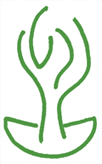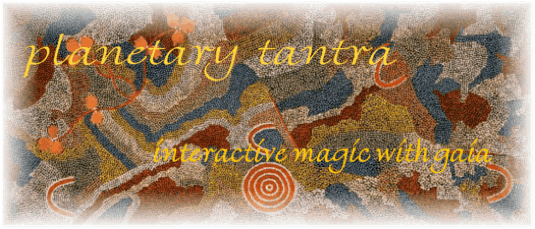| Site Guide |
| Tantra Tour |
| Gaian Tantra Vow |
| Foundations |
| SHAKTI CLUSTER | Dakini Calendar |
| Terma | Sierra de Libar |
Severed Rose (2)
Legacy of a Free-Lance Terton
1976 - 1996 Alchemy and Amor
When I review the years following my first encounters with the Organic Light, I see that I was pursuing an investigation that I failed to define in clear and cogent terms. The Mystery challenged me to engage it with a question. But, like Parzival, I just could not formulate the right question to address to the Organic Light. I did not even know what questions to ask, precisely, about the Light. But the Mystery continued, for it had implanted itself in my life. Even though the question to ask remained largely inchoate and unstated, I was living out that question in the pattern of my experiences. I call this method "fool's unknowing." Under the conditions of the Grail Quest, the one who attains that treasure must pose a question without being prompted to do so, and without being briefed beforehand about what to ask, and how to ask it. Unlike the motto of the Boy Scouts, "Be prepared," the motto for the Grail Quest could be, "Be unprepared." And that I certainly was.
Over time, the question I needed to ask formulated itself, sort of. Along the way, I found myself returning again and again to the alchemy connection. What led me to the Light was —well, you name it. Or what led the Light to me—same riddle. But those initial encounters were innocent and unknowing. Those revelations in 1965, 1966, and 1972 were inexplicable events through which the Supernatural impacted my life. I did not realize what I was actually seeing, but gradually clues emerged that led me to clear, testable knowledge of the nature and origin of the Organic Light, independent of my spontaneous encounters with it. The strange attractor for these clues was the arcane subject of alchemy.
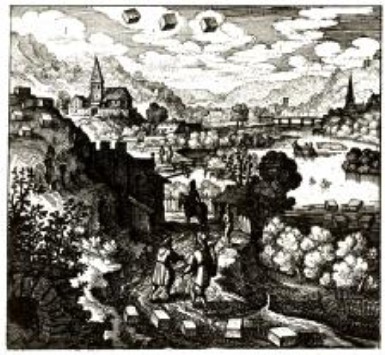
The "Atmospheric Stone". Michael Maier, Atalanta Fugiens
Alchemy Revised 1976 - 1986
Early in the course of my astrological studies, I delved into the work of C. G. Jung where I found a vast amount of information on alchemy. His books Alchemical Studies, Psychology and Alchemy, and Mysterium Coniunctionis, were among my most prized possessions. Jung himself used astrology in his practice, getting his wife Emma to calculate charts. However, I did not find Jungian archetypal psychology particularly helpful for the kind of astrology I was developing, relying as I did more on Maslov, Reich, and the humanistic school. What really fascinated me in Jung's work was the material of alchemy itself, the imagery, the odd uses of Latin, the obscure terms like Iliaster and Azoth, the fantastic images, the captivating allusions to magical processes in nature, and so on. Like everyone else who delves into this realm, I was fascinated by the mysterious nature of the Philosopher's Stone, the Stone of the Wise. This is certainly the supremely alluring and elusive item in Western esotericism, along with the Grail, with which it is often identified.
Throughout alchemical lore you find the constant assertion that the Stone is right there before your eyes, yet you cannot see it. Is this true of the Organic Light? In a sense, yes: were you to see the Organic Light, you would see it right before you, with your physical vision, eyes wide open. But it cannot be seen in the normal state of sense perception filtered by single-self identity, the egobound perspective. It comes to be seen with temporary dissolution of the sense of independent selfhood, melting the boundaries of normal perception. Alchemist who had seen the OL attested by crude imagery to its presence in the world of the senses. The illustration (above) from Atalanta Fugiens indicates the presence of "the Stone" (depicted as a cube) in the elements of nature, in the air, earth, water. It is present everywhere, permeating the natural world, but not found anywhere. Why not? Because it is co-present with material forms, but only comes to be seen when material mass is transfigured, right before your eyes. Then you realize that the Organic Light does not float in some mysterious way in matter, as the alchemical illustration suggests: matter floats in it.
Everything you see around you now, all sensuously perceived things large and small, including your body, are floating in it. All material forms are buoyed by the Organic Light in a way that induces levity in the beholder, a thrilling rush of expansion and elevation. This is an irrefutable fact of nature that can be confirmed by direct experience. Lacking such experience, it is extremely difficult to formulate the co-existence of sensuous materiality and the mass-free luminosity of the earth.
1980 - 6 : alchemy revisioned as an atmospheric science – The Course in forty lessons, including a complete course in terrastrology
1981 – 1991 Santa Fe : Institute for Creative Mythology
§ sometime early this period I had an audience with a high Tibetan lama
Returning from L.A. to Santa Fe in December 1980, I was deeply steeped in Anthroposophy, starwork, and alchemical studies. I struggled to realize by direct experience the nature of the Great Work as understood by genuine alchemists who had "attained the Stone," such as Jean-Baptiste von Helmont (1579 - 1644). To realize the "Great Work" in my own life and teach it to others became the driving imperative at that time, an all-consuming passion.
As I pursued this adventure of discovery, something odd kept catching my attention. Conventional historians of science disregard alchemy as an illusory system that preceded modern chemistry. Nevertheless, it seems that certain alchemists had turned over "secret knowledge" to the pioneers of chemistry, who then turned the secret tradition into mundane science. Isaac newton himself was fascinated by alchemy and wrote volumes on the subject. There are hints that other founders of modern science were influenced or instructed by alchemists or Rosicrucians versed in alchemy, unnamed figures standing in the background. Still, historians could not reconcile hard-core science with the apparent fantasy material of alchemy. Neither could I.
Von Helmont was the decisive revelation for me. Historians admit that von Helmont discovered carbon dioxide, which he called gas sylvestre, indicating that it is absorbed by trees. He also identified carbon monoxide, methane, and nitrous oxide. Hold on a second. If alchemy was the fantasy game of superstitious fools who did not understand how nature really works, how come one of its practitioners could have discovered these elements of the atmosphere before chemists had the instruments to identify them? And von Helmont was not the only one. I could cite several more examples... Alchemists also knew of the existence of nitrogen, the gas that composes 80% of the air we breath. They called it Azoth. It is said to be an inert gas we breath, which has no effect physically. Yet alchemists spoke in vivid, though veiled terms of Azoth and its effects. How could they know?
I was deeply intrigued by the idea that some alchemists of genuine attainment could have had intimate knowledge of the composition of the atmosphere of the earth before the era of modern chemistry. It occured to me that this would have been possible if they were interactive with the atmosphere, sensuously and cognitively. I began to see that alchemy could have been a kind of interactive yoga of the mind and senses, a practice aimed at full conscious integration of the human instrument into the atmosphere and biosphere. This concept was the germ of "The Course" I gave in Santa Fe in the 1980s. Students attended thursday night classes; others in California and New York took the lessons by correspondance. All in all, I had a "cell" of about 80 students engaged in this forty-lesson exercise.
I was able to offer The Course because I was privileged with a paramount insight about alchemy: what alchemists called the "Great Work" was coevolution with nature. Hence, a Gaian yoga of mind and senses. This was my first clue to the interactivity with Gaia later confirmed in the myth of the Aeon Sophia and brought to expression in Planetary Tantra. Within this insight there was another, even more potent realization: the Great Work was only possible if natural evolution was incomplete, requiring some kind of human participation to reach its full potential. Here I verged toward the notion of "Gaia's correction," long before I could define it as such, based on exact textual sources in Gnosticism. At that time I did not speak of correction, rather, I used the term incompletion. The Course was an invitation to investigate how our experience of nature remains incomplete until we enter into deep engagement with atmosphetic and biospheric processes, using the human body as the instrument (in alchemical jargon, the artifex) of transmutation. And by this engagement, the great design of nature completes itself, so the alchemists taught.
Arthurian Matter
In 1986 I was revising the original forty lessons of The Course into a tighter, more systematic presentation, breaking out the astrological material in separate lessons. In that year I had the rare opportunity to spend five months in Europe. I dedicated my journey to a "Celtic Quest," visiting places such as Glastonbury associated with the legend of the Holy Grail and the Knights of the Round Table. I travelled all oer Cornwall and Wales, visiting every stone circle and megalithic site in the region. I acquired a large library of books on the Grail Quest and the Knights of the Round Table.
In Wales I walked along the River Dee close to the site of Dinas Bran, the ancestral home of Parsifal. I was still deeply involved with Christocentric occultism, and influenced by Medieval Christian adaptations of the Grail. Authors such as Chretien de Troies and Robert de Boron identified the Grail with the chalice of the Last Supper, used by Joseph of Arimathea to collect blood from the crucified Savior. These were compelling tales that provided a deep mystical dimension for Christian faith, but I was a heretic at heart. Another version of the Grail Quest was taking form in my mind: the pre-Christian, Pagan vision of the Grail. Little did I know it at first, but I was now on the path of historical and legendary evidence for the Grail of the Mysteries, the Gaian Organic Light.
For me, exploring the "Arthurian Matter" was never a dry, scholarly endeavour, the dull business of consulting odd relics and frail parchments. At the risk of bad taste, I have to point out that there is ample textual evidence of wet panties in Arthurian lore. In Parzival and other epics, ladies thrilled by the phallic contest of jousting reward their favored knight with undergarments, the way frenzied women throw wet panties at a rock idol on stage. In fact, the entire genre of Arthurian lore is saturated with sexual lust. The ambience of the Grail Quest is erotically charged. In the Christian cooptation of the Quest, the one who seeks the Grail must be chaste, abstinent, free of sexual contamination. But in the Pagan view, the seeker who comes to the Divine Light will be a true voluptuary, illumined in the corporeal senses, sexually and mystically enlightened by that supernatural impact.
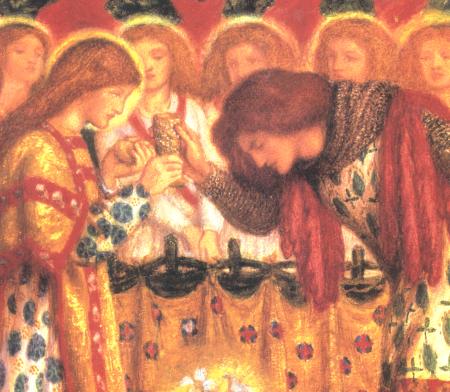
The "chaste" Sir Galahad receiving communion from the Grail Maidens.
Detail of painting by D. G. Rossetti
You must bring sexual innocence to the Organic Light—innocence, not abstinence, candor, not chastity—and lo and behold, the Light once encountered further endows and augments that innocence. Before the Grail, you are forever young.
My five-month Celtic Quest in 1986 was entirely a solitary adventure, with no occasion to woo or rescue damsels in distress. The breakthrough that finally allowed me to connect sexuality with the Grail came in another way: not through a flesh-and-blood woman, but through a question asked by a woman who lived in the halcyon days of the Arthurian Matter, the 13th Century. It came through a poem.
Romancing the Stone
In the mid 1980s when The Course was in full swing, I had a rare opportunity to connect with someone from my past. Professor C. F. Terrell of the University of Maine at Orono had taken me under his wing during my brief stint in college in 1963-64, before I took off for parts unknown. Terry was a Pound scholar, that is, an expert on Ezra Pound and the entire Modernist movement, Yeats, Joyce, Eliot, H.D. and all the rest. We met first in Boulder, Colorado where he was giving a talk at the Naropa Institute, and later he came to see me in Santa Fe. It was a fantastic visit, passed in sixteen-hour conversations on art and literature. Terry initiated me into the secret of crafting poetry ("the shape of the line") and clued me to the esoteric background of Romanticism and 20th century literature. I was set on fire by a passion to learn everything I could about Modernism, the brainchild of the Romantic Movement.
I started by reading The Spirit of Romance by Ezra Pound side by side with The Pound Era by Hugh Kenner. These two books alone revealed the continuity from medieval Romance, including the Arthurian Matter, all the way to Modernism. I learned how the troubadours were intimately connected to the Arthurian Knights and the Grail Quest. The "cult of amor" emerged in that mythogenetic moment that produced Parzival and Tristan. In The Spirit of Romance, Pound says explicitly that the mystical poets of that age identified the Grail with the Lady of their erotic songs. In Love in the Western World, Denis de Rougement makes the same assertion: the troubadour regards woman's body with the same awe as one who beholds the Grail. I compiled these parallels in a lecture I gave at the Institute of Creative Mythology. "The Secret of the Troubadours" was one the most well received and avidly discussed talks I ever gave in my studio at 707 Palace Avenue.
Central to Pound's astonishing study of the troubadours was a poem written around 1290 by Guido Cavalcanti, the mentor and teacher of Dante: Donna Mi Priegha, "A Lady Asks Me." This poem is a canzone, composed in rhyme and meter, meant to be sung with the accompaniment of a lute, troubadour-style. It is also a complex and subtle exposition of the power of love, a feat of unparalleled erotic language. The DMP is widely considered to be the greatest poem about love ever written. There have been more than fifty translations of the original, which is written in an obscure Tuscan dialect, close to Latin in many respects. Inspired by the meeting with Terry, I tried my hand at the DMP game. Terry brought out my translation of Donna Mi Priegha with a commentary by me in the 1986 edition of Paideuma, an international journal of Pound studies. It was the first thing I ever had published.
With Donna Mi Priegha, the link between alchemy and amor was permanently secured in my life. Consistent with the Romantic emphasis, I brought Mary Magdalene even more prominently to the front in my attempt to balance the gender bias of the saviour mythos. "No Christ without Magdalene" was my battle cry in those days, just about the time Holy Blood, Holy Grail appeared in the bookstores. In 1987, the year of the Harmonic Convergence, I gave a seminar entitled "The Gnostic Romance" to an Anthroposophy group in Hudson, New York. Amazingly, I was not yet well versed in the Magdalene references in the Gnostic Coptic writings. At that point in time I had still not begun the Gnostic studies that would lead to the recovery and restoration of the Sophia myth! I just had MM under my skin and I felt constantiy compelled to signalled her importance for modern spirituality.
Hero and Goddess
By the end of the 1980s I had amassed many clues to the Grail/Stone/Organic Light, but I was still lacking the ultimate key: the planetary source of that divine luminosity. Also, I had direct experience of beholding the Light, but not of interacting with it. Nor could I access it deliberately and repeatedly, by intention. All that was to come in the future.
1988 on : talks, workshops, and astrology in Santa Fe, L.A., Dallas. Also, writing The Seeker's Handbook, published in March 1991
§ writing Translations from the Andromedan, tertonic juvenalia that affords the translator an opportunity to elaborate on the prehistory of humanity, the chthonian romance of the Gaian tree-women and the men from Orion.
1991 October : leave the US to live in Europe, a permanent geographic change
§ living in Belgium, lecturing to the Nobility on the Grail Legend, tutoring a Belgian princess on astrology and Western esoterica
1993 : Twins and the Double published
§ talks and workships for an Anthropsophical group in Hudson, N.Y.
1995 : The Hero - Manhood and Power published, definitive break from the savior mythos and dillitante mysticism of Steiner et al.
As far as I had come toward realization of the origin and nature of the Organic Light, I still had a ways to go. The Christocentric bias impeded my progress, no matter how hard I tried to correct it through balance with a numinous divine counterpart, MM. The gruesome fact is, the messiah archetype is toxic, no matter how you play it. But such a deeply embedded psychic constellation it extremely difficult to extract. You have to cut it out at the tip of the root. An accomplished mystic must have extremely rigorous critical powers. The presence of a luminous male figure in the Organic Light cannot be denied—countless witnesses attest to this phenomenon, including C. J. Jung himself, in his vision of the Green Christ— but the identification of that presence has to be made with the utmost discrimination. I believe that Rudolf Steiner had witnessed the luminous phantom as I did, but then overlaid it with morbid Catholic fantasies derived from his religious conditioning. In his autobiography, The Story of My Life, he recounted a mystical vision of the "Mystery of Golgotha," describing how he was clairvoyantly present at the Crucifixion. This vision was without question the supreme moment of his mystical experience. It determined the quasi-religious message of Anthroposophy, which on those temrs is nothing more than off-planet salvationism made over into dilletante cultic indulgence for spiritual snobs.
Like Steiner, I was fixated on the magical dimension of the Golgotha event: namely, that the blood spilled by Jesus Christ imparted occult transformational powers to the atmosphere. In 1987 I wrote an article for the Anthroposophical journal, The Golden Blade, setting out this notion—my second published article after the DMP. This arcane notion was not unique to Steiner, however. It can be found explicitly stated by Gerhard Dorn (1530 - 1584), a Belgian alchemist privy to the rumor that the Grail, regarded as the chalice that received the blood of Christ, was kept in a small chapel in Bruges, Belgium. (From 1994 on I lived in Belgium where I frequently visited Bruges and investigated various alchemical legends associated with that town.) Dorn represents the elite corps of Rosicrucian alchemists who claimed a mystical understanding of the Passion of Christ. framed into a kind of atmospheric alchemy. But there is no trace of the Divine Feminine, Gaia, Sophia, or the sensuous earth in this glorious vision of terrestrial magic.
Jung was no help at all in sorting through such occult fantasias. In The Course I adopted his interpretion of the "Lapis/Christ Parallel." But the Lapis, i.e., the Organic Light, is not identical with the Christ-like luminous male figure that can appear in that Light. The Mesotes (as I name that figure, following Gnostic Coptic texts) is merely a reflex of human self-perception mirroring itself in the Organic Light, not consubstantial with it. Only Christianising alchemists identified Christ with the Lapis, the radiant stone of the Wise, but pre-Christian and Pagan tradition makes no association of the Grail with a messianic figure or supermundane savior. None at all. For Wolfram von Eschenbach, the Grail is a stone, not a cup or chalice, and the stone is not equatable to a human or superhuman person. The Jungian Lapis/Christ Parallel is a huge miscue. It cost me years of bleary-eyed distraction.
At this point, the reader may be ready to flee screaming from these pages, repelled by the sheer tedium of my account of what I had to work through so that I could communicate the mystery of the Organic Light in clear, accurate, and adequate terms, as I can do today. My apologies for dragging you through this recapitulation of my tertonic "achievements." What after all is the point? Perhaps just this: by seeing what I had to eliminate to recognize the origin and activity of the Organic Light, and present it in a way that is testable, you might register the specific rarity of that supernatural phenomenon. In other words, the difficulty in discerning exactly what it is is a measure of its incomparable status as a supernatural event.
To cut to the chase, I finally shed the last traces of Christocentric bias when writing The Hero, published in 1996. Almost at the same time, I picked up the Gnostic studies that led to the Sophianic vision of the Mysteries. In my view as a mythologist, the relation of the hero to the goddess is the paramount theme for human spirituality in our time. It is the touchstone to healing and regeneration, including the regeneration of sexuality and gender conflict. Connecting hero and goddess is the array of the animal powers, foremost being the lion, member and emblem of the feline species. The predatory felines with tear-drop markings are now the decisive emmisaries of Gaia-Sophia to the human species. They nurture and guide the heroism of humanity as a whole.
By contrast, the relation of humanity to the savior/messiah and, by extension, to the off-planet father god, is the pathological delusion that can take the species down. The messiah is the dominant archetype of the Piscean Age, not because it is the solution to the Age, but because it is the problem to be overcome, one person at a time, in order to realize what spiritual guidance really is. The saviour myth in any guise is toxic and delusional.
Each Zodiacal Age brings particular lessons to learn, and among them, one lesson will stand supreme. For the Ages of Pisces, the supreme lesson is how we are guided, both individually and as a species. The trajectory of my mystical experience with the Organic Light has defined that lesson for me, over and over again.
.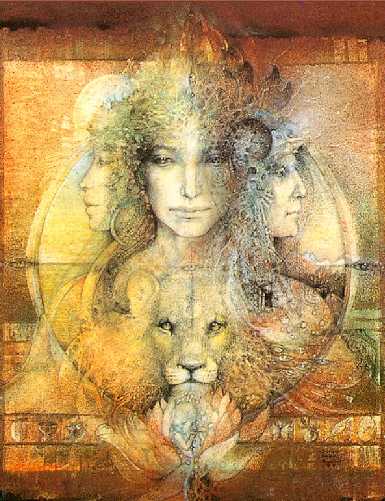
Triple Goddess with Lion by Susan Seddon Boulet
jll 27 September 2010 Flanders
